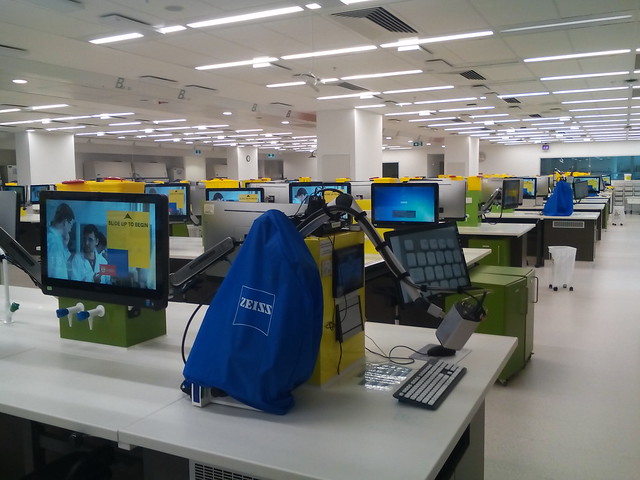A common teaching format is three one hour lectures a week and one tutorial of one hour. However, a student who has sat through three hours of someone talking at them in a darkened room is not likely to recall much, the following week when a tutorial is held.
With the flipped classroom the student reads material on-line on their own, watches some videos or listens to an audio podcast. They do a short quiz or exercise immediately after, to consolidate the learning. Within a few days they then attend a face-to-face session where they listen to a presenter for a few minutes, do a small group exercise, listen to the results from other groups.
Key to both distance education and the flipped classroom is to have the students doing something active. Also key is to have this activity assessed and to provide the students with feedback on how they are doing, as soon as possible.
But is it feasible to replace lectures and tutorials with a flipped classroom? Will it take too many new buildings and staff?
Consider a typical course with 300 students enrolled and tutorials of 20 students (from p. 4 "A Guide for Parents and Carers", 2016). A typical course will have three one hour lectures a week and one tutorial of one hour. Assuming a 300 seat lecture theater is available, one lecturer can provide the lectures in three hours and 15 tutor hours will be required per week. This would require a 300 m2 lecture theater for three hours and a 40 m2 tutorial room for fifteen hours per week (using usual space guidelines). This is a total of 5 m2 hours of floor space per student per week.
A cabaret style room requires about two and a half times as much floor space as a conventional lecture theater. However, saving is made in floor space, as each student spends less time in the room, with the flipped approach. There is also no need for a separate tutorial room.
Such large teaching spaces do exist, as an example, the University of Sydney "X-lab wet lab" accommodates about 240 students. However, the X-lab has a very sophisticated (and expensive) audio system allowing it to be divided for smaller classes.
A more workable option may be to divide a course into multiple sessions. This also provides the student with the option to choose a time which better suits them. A course of 300 students could be divided into two groups of 150. This would require a room of 375 m2, about 19 m2, with seventeen tables. This is a total of 2.5 m2 hours per student per week.
Each flipped class will require a lecturer to be the MC and about five tutors (one for each four tables and one to assist the lecturer). If each student undertakes one workshop of one hour per week, there would need to be two classes a week (or one a week for a two hour class).
The two hours of flipped class per week will require about the same amount of staff time as the four hours of lectures and tutorials. An emcee (equivalent of a lecturer) will be required for the two hours. While this is less than the three hours of lectures, they will also need to supervise the on-line component of the flipped class and handle the increased complexities of the flipped mode.
While only 10 hours of tutor time are needed in the face-to-face class, there will be extra work for the digital teaching in on-line classes.
One advantage of cabaret style teaching rooms is that they do not require a purpose built building. Libraries, offices and commercial buildings with flat floors can be re-purposed for cabaret style teaching These changes can be temporary, using mobile furniture and equipment. When not needed for classes the space can be used informally by students. The ANU Physics Studio, in a former chemical laboratory, is an excellent example of this approach.
The cabaret rooms, with movable furniture can be adapted for other teaching styles, best illustrated by the University of Canberra's Inspire building TEAL room*, which has semi-curricular flip top tables which can be quickly reconfigured during a class for different teaching styles, or packed away for a function.
Before cutting the space budget at universities, administrators need to consider where students will study when not in formal classes. With an emphasis on group work, students will need somewhere to do that group work. This will not involve an instructor and not be scheduled on the university timetable, but is still key to learning. Learning commons and uncommitted time in the flexible teaching rooms will be needed if the students are to meet on campus. Also students undertaking lab work with specialized equipment will need time to work.
In 2008 I gave up lectures and moved my teaching on-line. With new teaching spaces available it may soon be time to go back to the classroom. I will discuss some of this in "Dogfooding: Learning About Teaching by Being an On-line Student", for the ASCILITE Technology Enhanced Learning Special Interest Group Webinar (TEL edvisors), 4 May & Human Centered Computing Seminar, RSCS, ANU, 15 May 2017.
* ps: The University of Canberra's Inspire building TEAL room is colored teal (blue-green), which may be a joke by the designer.

No comments:
Post a Comment